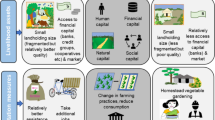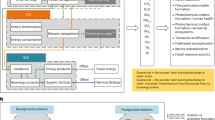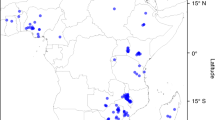Abstract
Mixed crop–livestock systems are the backbone of African agriculture, providing food security and livelihood options for hundreds of millions of people. Much is known about the impacts of climate change on the crop enterprises in the mixed systems, and some, although less, on the livestock enterprises. The interactions between crops and livestock can be managed to contribute to environmentally sustainable intensification, diversification and risk management. There is relatively little information on how these interactions may be affected by changes in climate and climate variability. This is a serious gap, because these interactions may offer some buffering capacity to help smallholders adapt to climate change.
This is a preview of subscription content, access via your institution
Access options
Subscribe to this journal
Receive 12 print issues and online access
$209.00 per year
only $17.42 per issue
Buy this article
- Purchase on Springer Link
- Instant access to full article PDF
Prices may be subject to local taxes which are calculated during checkout



Similar content being viewed by others
References
Seré, C. & Steinfeld, H. World Livestock Production Systems: Current Status, Issues and Trends (FAO, 1996).
Robinson, T. P. et al. Global Livestock Production Systems. (FAO/ILRI, 2011).
Herrero, M. et al. Smart investments in sustainable food production: Revisiting mixed crop–livestock systems. Science 327, 822–825 (2010).
Herrero, M. et al. Global livestock systems: Biomass use, production, feed efficiencies and greenhouse gas emissions. Proc. Natl Acad. Sci. USA 110, 20888–20893 (2013).
Liu, J. et al. A high-resolution assessment on global nitrogen flows in cropland. Proc. Natl Acad. Sci. USA 107, 8035–8040 (2010).
Sumberg, J. Toward a dis-aggregated view of crop–livestock integration in Western Africa. Land Use Policy 20, 253–264 (2003).
Bell, L. W. & Moore, A. D. Integrated crop–livestock systems in Australian agriculture: Trends, drivers and implications. Agric. Syst. 111, 1–12 (2012).
Boserup, E. The Condition of Agricultural Growth: The Economics of Agrarian Change under Population Pressure (Aldine, 1965).
McIntire, J., Bourzat, D. & Pingali, P. Crop–Livestock Interaction in Sub-Saharan Africa (World Bank, 1992).
Steinfeld, H. in Foods, Lands and Livelihoods: Setting the Research Agendas for Animal Science (eds Gill, M. et al.) 53–66 (British Society of Animal Science, 1998).
Baltenweck, I. et al. SLP Project on Transregional Analysis of Crop–Livestock Systems. Level 1 Report: Broad Dimensions of Crop–Livestock Intensification and Interaction across Three Continents (ILRI, 2003).
Herrero, M. et al. Exploring future changes in smallholder farming systems by linking socio-economic scenarios with regional and household models. Glob. Environ. Change 24, 165–182 (2014).
Waithaka, M. M., Thornton, P. K., Shepherd, K. D. & Herrero, M. Bio-economic evaluation of farmers' perceptions of viable farms in western Kenya. Agric. Syst. 90, 243–271 (2006).
Rufino, M. C. et al. Transitions in agro-pastoralist systems of East Africa: impacts on food security and poverty. Agric. Ecosyst. Environ. 179, 215–230 (2013).
Hobbs, N. T. et al. Fragmentation of rangelands: Implications for humans, animals, and landscapes. Glob. Environ. Change 18, 776–785 (2008).
Fritz, S. et al. Mapping global cropland and field size. Glob. Change Biol. 21, 1980–1992 (2015).
Norman, D. & Collinson, M. in Agricultural Systems Research for Developing Countries (ed. Remenyi, J. V.) 16–30 (ACIAR, 1985).
Wood, S. et al. in Food Security and Global Environmental Change (eds Ingram, J. S. I. Ericksen, P. J. & Liverman, D. M.) 46–62 (Earthscan, 2010).
Powell, J. M., Pearson, R. A. & Hiernaux, P. H. Crop–livestock interactions in the West African drylands. Agron. J. 96, 469–483 (2004).
Lemaire, G., Franzluebbers, A., de Faccio Carvalho, P. C. & Dedieu, B. Integrated crop–livestock systems: Strategies to achieve synergy between agricultural production and environmental quality. Agric. Ecosyst. Environ. 190, 4–8 (2014).
van Keulen, H. & Schiere, H. in New Directions for a Diverse Planet, Proc. 4th Int. Crop Science Congress (2004); http://www.cropscience.org.au/icsc2004/symposia/2/1/211_vankeulenh.htm
Russelle, M. P., Entz, M. H., Franzluebbers, A. J. Reconsidering integrated crop–livestock systems in North America. Agron. J. 99, 325–334 (2007).
Challinor, A. J., Parkes, B. & Ramirez-Villegas, J. Crop yield response to climate change varies with cropping intensity. Glob. Change Biol. 21, 1679–1688 (2015).
Roudier, P., Sultan, B., Quirion, P. & Berg, A. The impact of future climate change on West African crop yields: What does the recent literature say? Glob. Environ. Change 21, 1073–1083 (2011).
Knox, J., Hess, T., Daccache, A. & Wheeler, T. Climate change impacts on crop productivity in Africa and South Asia. Environ. Res. Lett. 7, 34032 (2012).
Niang, I. et al. in Climate Change 2014: Impacts, Adaptation, and Vulnerability. Part B: Regional Aspects (eds Barros, V. R. et al.) 1199–1265 (IPCC, Cambridge Univ. Press, 2014).
Porter, J. R. et al. in Climate Change 2014: Impacts, Adaptation, and Vulnerability. Part A: Global and Sectoral Aspects (eds Field, C. B. et al.) 485–533 (IPCC, Cambridge Univ. Press, 2014).
Thornton, P. K., van de Steeg, J., Notenbaert, A. & Herrero, M. The impacts of climate change on livestock and livestock systems in developing countries: a review of what we know and what we need to know. Agric. Syst. 101, 113–127 (2009).
Dixon, J. L., Stringer, L. C. & Challinor, A. J. Farming system evolution and adaptive capacity: Insights for adaptation support. Resources 3, 182–214 (2014).
Gabrielsson, S., Brogaard, S. & Jerneck, A. Living without buffers: Illustrating climate vulnerability in the Lake Victoria basin. Sustain. Sci. 8, 143–157 (2013).
Kristjanson, P. et al. Understanding poverty dynamics in Kenya. J. Int. Dev. 22, 978–996 (2010).
Ericksen, P. J. et al. Mapping Hotspots of Climate Change and Food Insecurity in the Global Tropics CCAFS Report No. 5 (CGIAR, 2011); https://ccafs.cgiar.org/publications/mapping-hotspots-climate-change-and-food-insecurity-global-tropics#.VbtxxY1dWp8
Jones, P. G. & Thornton, P. K. Croppers to livestock keepers: Livelihood transitions to 2050 in Africa due to climate change. Environ. Sci. Policy 12, 427–437 (2009).
Jones, P. G. & Thornton, P. K. Representative soil profiles for the Harmonized World Soil Database at different spatial resolutions for agricultural modelling applications. Agric. Syst. 139, 93–99 (2015).
Nachtergaele, F. O., Zanetti, M., Bloise, M. & Ataman, E. TERRASTAT Global Land Resources GIS Models and Databases (FAO, 2002).
Boote, K. J., Jones, J. W. & Hoogenboom, G. in Agricultural Systems Modeling and Simulation (eds Peart, R. M. & Curry, R. B.) 651–692 (Marcel Dekker, 1998).
IPCC Summary for Policymakers in Climate Change 2014: Impacts, Adaptation and Vulnerability (eds Field, C. B. et al.) (IPCC, Cambridge Univ. Press, 2014); http://ipcc-wg2.gov/AR5/
Matlon, P. & Kristjanson, P. in Challenges in Dryland Agriculture: A Global Perspective. Proc. Int. Conf. Dryland Farming (eds Unger, P. W., Jordan, W. R., Sneed, T. V. & Jensen, R. W.) 604–606 (Texas Agricultural Experiment Station, 1988).
Cooper, P. J. M. et al. Coping better with current climatic variability in the rain-fed farming systems of sub-Saharan Africa: An essential first step in adapting to future climate change? Agric. Ecosyst. Environ. 126, 24–35 (2008).
Jones, P. G. & Thornton, P. K. Generating downscaled weather data from a suite of climate models for agricultural modelling applications. Agric. Syst. 114, 1–5 (2013).
Thornton, P. K., Ericksen, P. J., Herrero, M. & Challinor, A. J. Climate variability and vulnerability to climate change: A review. Glob. Change Biol. 20, 3313–3328 (2014).
Greatrex, H. et al. Scaling Up Index Insurance for Smallholder Farmers: Recent Evidence and Insights CCAFS Report No. 14 (CGIAR, 2015).
Gonzalez-Estrada, E. et al. Carbon sequestration and farm income in West Africa: Identifying best management practices for smallholder agricultural systems in northern Ghana. Ecol. Econ. 67, 492–502 (2008).
Valbuena, D. et al. Conservation agriculture in mixed crop–livestock systems: Scoping crop residue trade-offs in Sub-Saharan Africa and South Asia. Field Crops Res. 132, 175–184 (2012).
Rufino, M. C. et al. Competing use of organic resources village-level interactions between farm types and climate variability in a communal area of NE Zimbabwe. Agric. Syst. 104, 175–190 (2011).
Tittonell, P. A. et al. Analysing trade-offs in resource and labour allocation by smallholder farmers using inverse modelling techniques: A case-study from Kakamega district, western Kenya. Agric. Syst. 95, 76–95 (2007).
Klapwijk, C. J. et al. Analysis of trade-offs in agricultural systems: Current state and way forward. Curr. Opin. Environ. Sustain. 6, 110–115 (2014).
Ryschawy, J., Choisis, N., Choisis, J. P. & Gibon, A. Paths to last in mixed crop–livestock farming: Lessons from an assessment of farm trajectories of change. Animal 7, 673–681 (2013).
Bell, L. W., Moore, A. D. & Kirkegaard, J. A. Evolution in crop–livestock integration systems that improve farm productivity and environmental performance in Australia. Europ. J. Agron. 57, 10–20 (2014).
Osman-Elasha, B. et al. Adaptation Strategies to Increase Human Resilience against Climate Variability and Change: Lessons from the Arid Regions of Sudan AIACC Working Paper No. 42 (International START Secretariat, 2006); www.aiaccproject.org
Nhemachena, C. & Hassan, R. Micro-Level Analysis of Farmers' Adaptation to Climate Change in Southern Africa Discussion Paper 00714 (Environment and Production Technology Division, IFPRI, 2007).
Harvey, C. A. et al. Extreme vulnerability of smallholder farmers to agricultural risks and climate change in Madagascar. Phil. Trans. R. Soc. B 369, 20130089 (2014).
Thornton, P. K. & Herrero, M. Climate change adaptation in mixed crop–livestock systems in developing countries. Glob. Food Security 3, 99–107 (2014).
Havlík, P. et al. Climate change mitigation through livestock system transitions. Proc. Natl Acad. Sci. USA 111, 3709–3714 (2014).
Glover, J. D. et al. Increased food and ecosystem security via perennial grains. Science 328, 1638–1639 (2010).
Rivington, M. et al. An integrated assessment approach to conduct analyses of climate change impacts on whole-farm systems. Environ. Model. Softw. 22, 202–210 (2007).
Kalaugher, E., Bornman, J. F., Clark, A. & Beukes, P. An integrated biophysical and socio-economic framework for analysis of climate change adaptation strategies: The case of a New Zealand dairy farming system. Environ. Model. Softw. 39, 176–187 (2013).
Van Etten, J. Crowdsourcing crop improvement in sub-Saharan Africa: A proposal for a scalable and inclusive approach to food security. Inst. Dev. Studies Bull. 42, 102–110 (2011).
Fritz, S. et al. Geo-Wiki: An online platform for improving global land cover. Environ. Model. Softw. 31, 110–123 (2012).
Garnett, T. et al. Sustainable intensification in agriculture: Navigating a course through competing priorities. Science 341, 33–34 (2013).
Scoones, I. & Wolmer, W. Pathways of Change: Crops, Livestock and Livelihoods in Africa. Lessons from Ethiopia, Mali and Zimbabwe (Institute of Development Studies, Univ. Sussex, 2000).
Vervoort, J. et al. Challenges to scenario-guided adaptive action on food security under climate change. Glob. Environ. Change 28, 383–394 (2014).
Brooks, N. et al. Tracking Adaptation and Measuring Development Climate Change Working Paper No. 1 (IIED, 2011).
Delaney, A. et al. A Systematic Review of Local Vulnerability to Climate Change: In Search of Transparency, Coherence and Compatibility CCAFS Working Paper No. 97 (CGIAR, 2014).
Lipper, L. et al. Climate smart agriculture for food security. Nature Clim. Change 4, 1068–1072 (2014).
Campbell, B. et al. Sustainable intensification: What is its role in climate smart agriculture? Curr. Opin. Environ. Sustain. 8, 39–43 (2014).
You, L. et al. Spatial Production Allocation Model (SPAM) 2000 Version 3 Release 1 (MapSPAM, 2012); http://MapSPAM.info
CIESIN Gridded Population of the World Version 3 (GPWv3): Population Grids (SEDAC, 2005); http://sedac.ciesin.columbia.edu/gpw
Acknowledgements
P.K.T. acknowledges the support of CCAFS and a CSIRO McMaster Research Fellowship. The CGIAR Research Program on Climate Change, Agriculture and Food Security (CCAFS) is funded by the CGIAR Fund, AusAid, Danish International Development Agency, Environment Canada, Instituto de Investigação Científica Tropical, Irish Aid, Netherlands Ministry of Foreign Affairs, Swiss Agency for Development and Cooperation, Government of Russia, UK Aid and the European Union, with technical support from the International Fund for Agricultural Development. We thank J. Kiplimo for producing the maps.
Author information
Authors and Affiliations
Contributions
P.K.T. and M.H. designed and wrote the paper together.
Corresponding author
Ethics declarations
Competing interests
The authors declare no competing financial interests.
Rights and permissions
About this article
Cite this article
Thornton, P., Herrero, M. Adapting to climate change in the mixed crop and livestock farming systems in sub-Saharan Africa. Nature Clim Change 5, 830–836 (2015). https://doi.org/10.1038/nclimate2754
Received:
Accepted:
Published:
Issue Date:
DOI: https://doi.org/10.1038/nclimate2754
This article is cited by
-
Priority areas for investment in more sustainable and climate-resilient livestock systems
Nature Sustainability (2023)
-
Aiding food security and sustainability efforts through graph neural network-based consumer food ingredient detection and substitution
Scientific Reports (2023)
-
Characterising Productivity Factors Affecting Maize (Zea mays) Production in a Smallholder Crop-Livestock System
Agricultural Research (2023)
-
Coping with and adapting to climate and non-climate stressors within the small-scale farming, fishing and seaweed growing sectors, Zanzibar
Natural Hazards (2023)
-
The new Malthusian challenge in the Sahel: prospects for improving food security in Niger
Food Security (2023)



